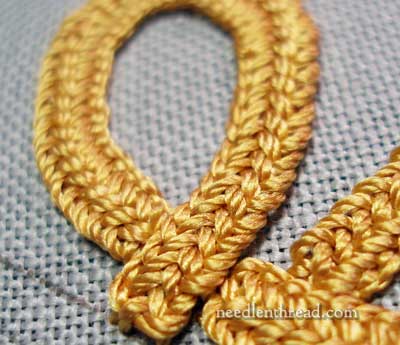I’ve often considered myself a bit of a thread hog. I tend to hog threads. I like threads! And I have a lot of them! But I’m not really calling myself names here, nor am I calling anyone else a name. Instead, I’m referring to a stitch – the plaited braid stitch – which, as mentioned the other day, eats thread like a whale eats plankton.
To show you just how much of a Thread Hog plaited braid stitch is, I’ve done some calculating for you. And when I do calculating, it’s a Big Deal, because I am not, by nature, a calculator.

So, I set out to test plaited braid stitch using Trebizond silk, on a simple interlocking knot pattern.
The pattern is approximately 2.5″ x 2.5″ from tip to tip, horizontally and vertically. The parallel lines of the pattern are between 1/8 – 1/4″ wide (about 3/16″). The finished line ends up a bit wider than that, because the braid fills over the lines slightly, so the finished braid is about 1/4″ wide.

The interlocking paths don’t actually cross over each other, though they look like they do. They just sort of butt up next to each other.

Here’s where I’m approaching the finish – not too much left to go there – around an inch of the path left to fill…

Oops – only 3/4″ left to go to finish the whole knot! Unfortunately, this is what my spool of Trebizond looked like at this point. I didn’t start with a full spool, but I started with a good amount of thread on the spool, and I thought I had enough to work the whole knot with plaited braid.

Whew. I had Just enough.

My favorite part of the knot is the intersection in the center.

And of course, I love the smooth, thick filling created by the plaited braid and Trebizond.
The color of the Trebizond is burnished gold (#231) – it’s a lovely gold color. The background fabric is Puritan Gray by Legacy Linen, a 34-count linen in a medium soft gray. I really didn’t intend to combine these colors for any specific reason. I had the scrap of linen available, and I had this spool of Trebizond available, and so they were fated to become this sample. They’re “ok” together – they remind me of a uniform with trim – but I probably wouldn’t normally combine them. I used a tapestry needle, by the way, to work the stitch – a size 22, I believe. The tapestry needle is essential when working this stitch with the Trebizond. A needle with a sharp point would wreak havoc on the thread.
So, with the finished motif, let’s look at some figures, just to establish whether or not plaited braid stitch really is a Thread Hog.

That’s how I do my figures. My grade school math teachers probably wouldn’t be too impressed. But I can read it, so that’s all that matters, right?
The design ends up being 11 inches long. If you stretched the whole knot out straight, the resulting path would be 11 inches long.
It took me approximately 205.5″ inches of Trebizond to work the knot – that’s about 17 feet, or 5+ yards of thread! There are 11 yards of Trebizond on a spool, so it took just around half the spool to work the knot.
That is One Hungry Stitch.
Keep in mind, tension and spacing have a lot to do with the amount of thread used. Also, if your thread is thicker, you might not use as much. If it is finer, you might use more.
Now, the question is, fiddling with other braid-type stitches, how do other stitches compare to this one, when it comes to thread eating? I may have to explore that question!
Any questions, comments, suggestions, wonderings, musings, inspirations you’d like to share on this topic? Feel free to leave a comment below!
